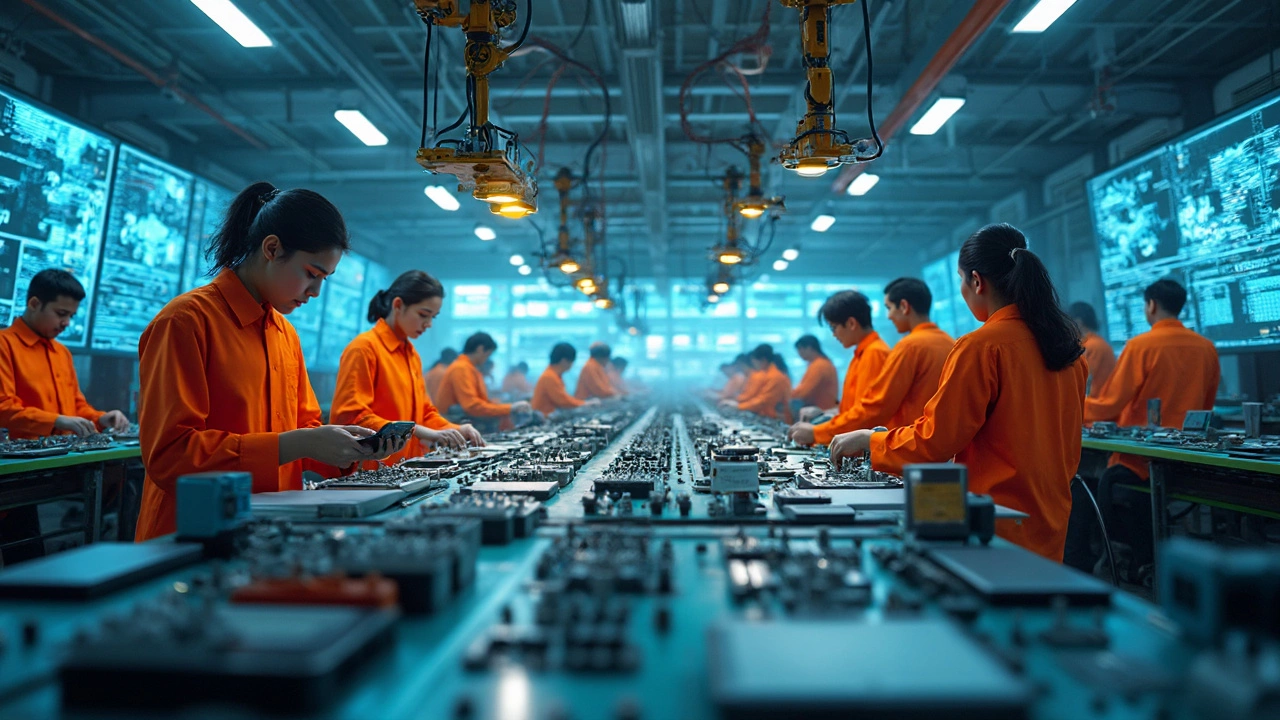
Picture this: the gadget in your hand, the laptop on your desk, the smart fridge humming in your kitchen—chances are, there’s a “Made in China” sticker somewhere on them. Turns out, for most modern electronics, that’s no coincidence. China has transformed itself from a manufacturing underdog into an all-out juggernaut, making more electronics each year than any other country by a staggering margin. And it’s not just smartphones or tablets at stake here, it’s everything from tiny circuit boards to industrial robots and massive data servers. With the world’s demand for electronics growing each day, the scale at which China churns out these devices is almost hard to imagine, but behind those export numbers are real people, massive factories, dizzying logistics, and clever strategies that make it all possible.
How China Became the Global Electronics Powerhouse
China wasn’t always the world’s hardware headquarters. Fast forward a few decades, and it’s a very different story. The 1980s and 90s marked China’s industrial boom. Forward-thinking government investments, low labor costs, impressive infrastructure projects, and a willingness to open up to foreign companies turned cities like Shenzhen from tiny fishing villages into sprawling tech hubs. Today, Shenzhen alone makes more electronics in a year than some countries do over an entire decade, and it’s home to tech giants like Huawei, DJI, and Tencent. What’s wild is that around 70% of the world’s smartphones are assembled in China, and out of the top 10 largest electronics suppliers globally, at least six are either Chinese companies or have major bases inside the country.
If you ask Apple, Nintendo, or HP why they manufacture in China, the answers sound simple: access to skilled workers, mature supply chains, and the sheer speed at which things can get done. A single city block in Shenzhen might house dozens of factories—from screen printing shops to microchip fab units—meaning a prototype for a new gadget can get built, tested, and shipped in days, not months. The whole ecosystem works a bit like a high-speed assembly line stretching across industrial zones, all the way to cargo ports where containers are shipped out every single minute.
Let’s pause for a second: what does that supply chain even look like? It’s massive, coordinated, and surprisingly nimble. Every piece, from raw minerals mined in far-off provinces to capacitors and processors, passes through this maze of suppliers and sub-suppliers. It’s not always glamorous—factory work can be intense and repetitive, and stories of worker exploitation have surfaced—but efficiency is king. There's a common saying among industry veterans: “If you want to build something fast, build it in China.” Even the chip shortage that swept the world in the 2020s didn’t dent China’s dominance. Factories rerouted supplies, tweaked designs, and kept the output humming.
Want to see the numbers? Here’s a quick look at how major electronics-producing nations compare, based on 2023 data:
| Country | Annual Electronics Output (USD) | Global Market Share (%) |
|---|---|---|
| China | $2.5 trillion | 38% |
| United States | $520 billion | 8% |
| South Korea | $410 billion | 6.3% |
| Taiwan | $370 billion | 5.5% |
| Japan | $330 billion | 5% |
To put this in perspective: China outpaces its closest competitors several times over. Even the United States, with Silicon Valley and all its tech legends, produces less than a quarter of what China puts out. “China’s manufacturing scale is unlike anything else on Earth,” says Sarah Yao, an analyst at Canalys.
“It's not just about low costs, but the ability to move quickly, source parts locally, and adapt instantly to changes in demand.”If a global hit gadget like the iPhone needs 200 million units made in a year, China is the only place set up to handle that kind of rush. And for smaller startups trying to launch something new, these same factories offer the speed and flexibility that can mean the difference between success and going bust.

The Tech Behind Mass Production: Secrets of the Assembly Line
The inside of a modern Chinese electronics factory is nothing like the grimy, dimly lit warehouses you might imagine. These places are often ultra-clean, well-lit, and packed with robots and precision machines whirring away alongside assembly workers. Automation is everywhere: robotic arms weld, solder, glue, and even test finished devices. But even with all these high-tech tools, human hands still play a big role. There’s a fine balance between machine efficiency and human dexterity—some steps, like placing tiny connectors, are still faster and more accurate when done by experienced workers.
Factories rely on something called “just-in-time” manufacturing, where parts arrive exactly when they’re needed. No endless stockpiles or wasted warehouse space—just a steady, beautiful dance of trucks, conveyors, and people. For example, when a smartphone is getting built, the camera module might come from a supplier in a neighboring building, the casing from another floor, and the final chips from a plant down the street. The goal? Get the phone on the conveyor, assembled, tested, boxed, and shipped out in less than 24 hours. Some plants claim they can bolt together a smartphone every two seconds when demand spikes.
There’s also the magic of rapid prototyping. Shenzhen’s famous Huaqiangbei market is legendary among inventors and engineers—need a new circuit board? You can sketch it out in the morning, get it built by lunch, and have a working prototype tested before dinner. And the tech community in these markets is surprisingly open; you’ll see teams from all over the world crowdsourcing ideas, swapping parts, and trading tips on the fly. That’s a big reason why so many tech start-ups head to China to turn their ideas into real-life gadgets.
Of course, no system is perfect. Labor conditions have sometimes made headlines for all the wrong reasons. Reports have exposed long hours and safety violations, pushing watchdogs and tech giants to enforce stricter rules and frequent audits. Most factories for the world’s biggest brands are now monitored by independent ethics panels and labor rights NGOs, and improvements—like better wages, onsite medical clinics, and overtime limits—are popping up across industrial zones. Still, it’s a work in progress.
Something most folks don’t realize is how eco-minded some Chinese electronics companies have gotten in recent years. With pressure from international brands and tighter Chinese regulations, you’ll find plants that recycle water, run on renewable energy, or have zero landfill policies. There’s even a cottage industry in refurbishing and reusing old electronic components—turns out, what’s junk to one company can be a valuable part to another. It’s these hidden innovation stories that quietly shape the world of mass production.
You might think all this manufacturing would grind to a halt when disasters strike—supply chain chaos, pandemics, trade wars—but here’s where Chinese logistics shine. Factories found creative workarounds during COVID-19: housing employees onsite in “bubble dorms” to keep work going, or repurposing lines to churn out medical equipment when phones and tablets weren’t selling. That flexibility is a massive reason why the electronics tap never really runs dry.

What the Future Holds: Challenges and Innovations in Global Electronics
So, does China just stay in the electronics driver’s seat forever? Lately, the landscape is shifting in all kinds of weird and interesting directions. Other countries are trying to get a piece of the action, especially as supply chain bottlenecks and trade disputes rattle nerves. Viet Nam, India, and Mexico are rolling out tax incentives, free-trade zones, and new factories designed to catch the eye of big tech brands. Apple, for example, started building some of its iPhones in India, and Vietnam is pumping out tablets and smart devices. But even with these efforts, China’s lead isn’t shrinking much yet. One key reason: the intricate web of suppliers, factories, and talent can’t be built overnight. It’s like an ecosystem—complex, interconnected, and tough to copy outside China.
The real challenge might come from within. Demographics are changing—China’s working-age population is shrinking, and younger workers are less interested in factory gigs. Add in rising wages, tightening environmental rules, and growing competition from robot-powered plants, and the pressure is on for Chinese manufacturers to adapt. More and more factories are introducing AI-driven systems to spot defects or optimize workflows, and robotics engineers are suddenly high in demand. Some companies are betting big on "smart factories" where nearly every step is tracked, automated, and tweaked by algorithms to save time and slash waste.
Green tech is another area to watch. Global buyers want eco-friendly devices, so factories are shifting to solar power, plugging into “clean” recycling loops, and even designing gadgets to be easier to repair or upgrade. In 2024, a famous Chinese phone-maker launched a modular phone where you can swap major parts with a single screwdriver. The pilot program was a hit among students and young professionals, and it’s a sign of how the market is finally listening to what users want—not just churning out disposable devices by the millions.
For anyone buying gadgets, there’s a hidden upside to all this competition: prices tend to drop, and product quality keeps rising. Supply chains from China are so efficient that it’s easy to get high-end features for budgets that would have bought you a clunky device just five years ago. And for the gadget tinkerers or would-be inventors out there, the open markets in places like Shenzhen give you a shot at building something from scratch without breaking the bank. So, next time you hold a new phone or a Bluetooth speaker, remember—it’s part of a global story that zips from a designer’s sketchpad to a million-strong assembly line and then lands right in your palm, thanks to the massive engine that is China’s electronics industry.
The world’s appetite for new gadgets isn’t slowing down anytime soon, and neither is the drive for better, faster, and greener manufacturing. For now, China’s unbeatable mix of scale, speed, and supplier networks keeps it firmly in the lead. Still, no one can predict what the next innovation or crisis will bring. Maybe in a few years, a new country will step up—or a breakthrough in automation will change how everything’s made. But for anyone watching technology shape our daily lives, it pays to keep an eye on the world’s largest electronics manufacturing hub, because almost every device you touch has a story that starts there.